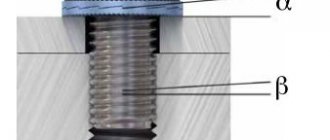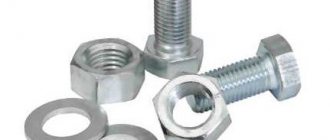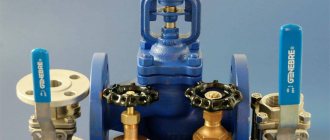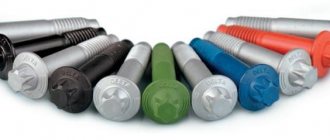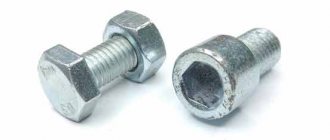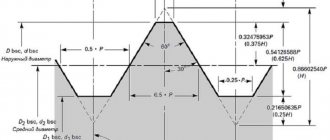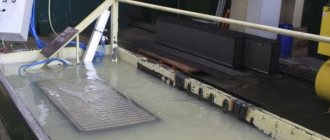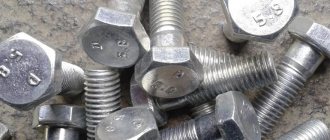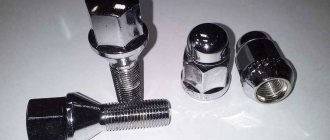All threaded fasteners are prone to self-tightening under the influence of external forces such as vibration, wind, dynamic and shock loads. If they are not securely locked, this can lead to the most serious consequences. There are known cases when a loose nut or bolt caused a mechanism to break down and cause serious accidents.
There are many ways to prevent loosening of threaded connections, which are based either on the principle of rigid locking (cotter pins, bending washers, wire) or frictional, that is, by increasing the friction force (lock nuts, elastic washers, self-locking nuts).
Main types of self-locking nuts
How do self-locking nuts work?
As the name suggests, a self-locking nut does not require additional locking parts or other methods of protection against self-loosening. It has a specific locking mechanism that is integral to its design, making it suitable for use in high vibration environments.
Many types of such self-clamping lock nuts have been developed and each of them has become widespread. As a rule, their self-locking on the mating thread of the bolt occurs due to an increase in the friction force in the threads. For example, it may have a nylon ring or a deformed thread section, that is, there is some part of it that elastically deforms to provide frictional action.
What are dominant torque nuts?
This is what many foreign manufacturers and developers of these products call self-locking locknuts. By definition, "torque-dominant fasteners have a self-contained function that creates frictional interaction between the threads of mating components."
Self-locking nuts cannot rotate freely on the mating threaded rods, so during both assembly and disassembly you will encounter significant rotational resistance that requires additional force to overcome. This resistance is called the "predominant torque". The greater the degree of deformation, the higher the required torque for installation and removal.
For example, for a nut with a nylon insert, this is the torque required to overcome the drag resistance of the nylon on the mating thread. Its value is usually not very large compared to the final installation torque.
Advantage over freewheel nuts
Free-rotating lock nuts often rely on an additional locking element such as a lock washer or toothed flange. However, after the initial loosening, they cease to resist unscrewing, which can quickly lead to complete disassembly of the connection.
Torque-dominant fasteners do not have this disadvantage, since after a slight loosening of the tightening, they continue to resist further unscrewing due to friction. Even with strong vibrations, the mating parts will remain screwed together.
Nylon ring nut or all metal?
There are many types of self-locking torque nuts, many of which are patented or meet specific design standards, but generally they can be divided into two categories:
- all-metal
- with non-metallic insert
Locking nuts: solid metal and with nylon insert
Nuts with a polymer insert have a non-falling nylon ring, rolled into the upper part of the thread and creating the necessary tension when tightened on the bolt to lock the threaded pair. They are reusable because once removed the elastic nylon insert returns to its original shape. They can be installed in places where temperatures reach 120 degrees Celsius. At critically high temperatures, it is recommended to use all metal locknuts.
All solid metal self-locking nuts provide their locking action through some change in shape—most often through a deformed section of the nut thread that cuts into the mating part when tightened. This means that more force must be applied both to assemble and disassemble the joint. Additionally, they are all metal, so they can be used in areas where there is exposure to certain chemicals and elevated temperatures, up to 750 degrees Celsius.
Thus, each type of locknut has its own advantages and disadvantages, namely:
- Solid metal lock nuts have fewer temperature and chemical restrictions, but are prone to thread galling and are difficult to thread onto long bolts.
- Products with non-metallic liners have temperature limitations and are not resistant to some chemicals, but can be screwed onto long bolts without damaging the threads. In addition, since the non-metallic element fits tightly against the mating threads, it provides an effective seal to the connection.
Warped solid metal nuts
International standards do not impose strict requirements on the design and dimensions of counter elements, allowing for different options for their design. This explains the fact that all-metal self-locking nuts, made according to the same standard, may differ in the shape and design of the locking elements. Let's consider the most famous versions:
Distorted section of thread.
This is the most common design of an all-metal torque-dominant nut, in which the threads in some areas are intentionally skewed. This provides a vibration-resistant, frictional fit of the fastener that is more secure than a locknut with a nylon insert.
Deformation into an ellipse.
This is a hex nut with a conical or cylindrical protrusion, which is plastically compressed so that the threaded hole in this part has an oval cross-section. It rotates freely until its deformed top threads engage the mating threads, then it expands to a nearly circular shape, creating a locking compression. These are one-way lock nuts, meaning they can only be installed in one direction - with the crimped side facing out.
Three-point end compression.
The locking of a nut with such a locking element occurs in the upper part, as in the elliptically deformed model, except that not the entire section of the upper thread is deformed, but only two or three small sections. This is quite enough for a reliable frictional fit on the bolt.
Central locking.
Also known as double-sided locknuts, they can be screwed onto either side of the stud. They are compressed in the radial direction along the edges or along the ribs in the central part of the fastener, as a result, the thread diameter in these places decreases. The deformed area perfectly prevents the fasteners from unscrewing freely. One type is the Biloc nut.
DIN 980 form M
All-metal self-locking nuts with a metal insert made of spring steel (for example, DIN 980 form M) are also in great demand in industry. An additional metal elastic element in the form of a ring, compressed into an ellipse or polyhedron, ensures reliable locking on the threaded rod due to elastic deformation.
Thread locker to prevent it from unraveling
Often it is necessary to tighten a bolt or screw so that it does not unwind, at least on its own, under the influence of the environment. The subject of this review is intended to solve this problem. Below the cut is a review and test drive of an anaerobic gel for fixation. When I wrote about anaerobic sealant, there were many questions in the comments about its capabilities for fixing threads. I replied that there are other products for this, and we will consider one of them. In conditions of a consistently unstable exchange rate, Russian-made products often turn out to be more interesting than their foreign counterparts. When I ordered pipe sealants, I also added this fixative to the cart. Delivery from the manufacturer is paid up to a certain amount (500 rubles - 6.5 $), so it makes sense to get goods up to this amount. Now I got around to dealing with this product. The parcel arrived in about a week and a half, the manager of the transport company called and arranged delivery. The main product there was, of course, Plumbermaster gel, which caused a great response among readers. I ordered the thread locker as an extra.
Here is what the manufacturer writes about this clamp (I have summarized a little information from different places on the manufacturer’s website): - replaces lock washers, reliably fixes bolts over M20; — can be used in joints from -0.2 to +0.6 mm, to fill microdefects in welds, castings, rolled products, pressed materials; - sealing immediately after application (final polymerization occurs after 15-30 minutes - the product blocks the part); — strong tightening is not required during assembly; — resistance to abrasion, high mechanical loads, and temperature changes; — protection against corrosion due to high adhesion to metal; — resistant to organic solvents; - does not creep, does not shrink, increases structural strength; — operating temperature range from -60 to +150 °C; — dismantled with heating up to +150 ºC; - Protects threads from corrosion.
Well, let's check its properties. In general, it is very important to fix the threads, especially in moving parts. For me, thread locker was very helpful in ensuring the stability of the connections in the automated greenhouse design I described here.
The thread locker is packaged in a blister:
It should be noted that they are available in 4 types: with easy-to-disassemble fixation, durable, for large threads and high-strength. We have the light version in our hands: with easy-to-disassemble fixation. On the reverse side instructions for use:
Weight with packaging 27 g:
The tube can be removed very easily, the weight of the tube is 14g:
Tube length is about 12 cm:
The cap on the tube is fixed with a thread; inside there is a bluish gel:
The tip of the tube is thin, which, combined with pressing on the tube, makes it easy to dispense the dispensed gel.
I’ll write down the features of these gels right away to avoid unnecessary questions. Gels are anaerobic - that is, they harden without air. In narrow places, in particular, at the point of contact between a nut and a bolt, or a self-tapping screw and a twisted surface, the amount of air is minimal - that’s where this gel polymerizes. The remaining gel on the outside does not harden and should be removed with a cloth.
For tests, let's take a few bolts and nuts. The seller claims to work even on M20 thread bolts, but the maximum I had was M10:
The candidates lined up are:
Lubricate 3-4 turns on each bolt:
From a large bolt, part of the gel flows onto a piece of paper; it is quite liquid, so it is probably better not to place it horizontally after lubricating it. We collect the compounds and wait for polymerization for 30 minutes:
On the left side of the piece of paper is a puddle left by a large bolt.
While the polymerization process is underway, I decided to assemble another structure. After the last review of anaerobic pipe sealant, people wrote in the comments about a vibration test. This time we can’t do a pressure test, but I think we can get vibration. What could be better suited for such tests than a children's metal construction set? I didn't find anything better and borrowed the following from the child:
Inside, as you would expect, there are structural elements and screws with nuts:
We will not assemble an airplane or a tractor, we will assemble a simple spear like this, using a simple tool from the construction set (the screwdriver fits into the screw slot with great force, uncharacteristic for children of the age indicated on the construction set - we will leave this to our conscience class=»aligncenter» width=»800 ″ height=”600″[/img] At the same time, I twisted the right part, marked with a blue marker, using our thread locker. I note that I twisted the screws with the same force, without fanaticism, but so that it would hold. Let’s leave the simple design to dry.
In the meantime, the moment of truth has come for our bolts, we try to unscrew them (30 minutes have passed). I was unable to turn the nuts by hand, but with the help of an adjustable wrench, the screwed nuts began to move with medium force. If you need to assemble a non-dismountable connection, you should resort to versions with strong and high-strength fixation. The polymerized sealant looks like this:
Now let's move on to our constructor. To create vibration, I decided to use a compressor that survives the winter on the balcony:
We fix our structure with clothespins, we don’t need strength, rather the opposite - the more it dangles, the better:
We turn it on and see how the structure vibrates. After 5 minutes of work, the structure changed its original appearance:
We can conclude that the thread locker helps to cope with the self-unscrewing of bolts and screws.
In general, we can say that the thread locker copes with its task; no problems arose when using it. The threaded connections fixed with this gel in my greenhouse did not cause any problems. So I can recommend it.
For dessert, the vibration video, unfortunately, did not wait for the collapse of the half without sealant:
Thanks to everyone who read to the end, I hope this information will be useful to someone.
Common standards for self-locking nuts:
- DIN 980, 982, 985, 986, 6924, 6925, 6926, 6927
- ISO 7040, 7042—7044, 7719-7720, 10511—10513
- EN 1663, 1664, 1666, 1667
- GOST R 50271-92, GOST R 50272-92, GOST R 50273-92
There are other proprietary torque-dominant designs of metal locking nuts on the market, so the information provided is not exhaustive.
The final quality control of nuts with a self-locking function is based on measuring the screwing and unscrewing torques, the values of which must comply with established standards. In the domestic industry, the following standards have been established for the maximum moment of the first screwing (M1zav) and the minimum moment of the fifteenth unscrewing (M15otv).
Standards for the locking properties of self-locking nuts:
| Thread | M1zav (maximum), N*m | M15hole (minimum), N*m |
| M3 | 0,7 | 0,03 |
| M4 | 0,9 | 0,1 |
| M5 | 1,3 | 0,15 |
| M6 | 2,7 | 0,2 |
| M8 | 4,9 | 0,4 |
| M10 | 6,9 | 0,6 |
| M12 | 9,8 | 1,0 |
| M14 | 12,7 | 1,5 |
| M16 | 15,7 | 2,0 |
How to apply
First, you need to be sure that the bolt in question simply requires the application of thread locker. To find out, you need to find the repair manual for your car and read it. Typically this information is written in the same section as the tightening torques.
If you are confident, then open the tube with the fixative and apply a strip of about 5 mm (usually one drop) to the thread, in the place of the bolt where the nut will be located. When you tighten the bolt, the fastener will distribute itself over the contacting surface.
Can self-locking nuts be reused?
There is some controversy as to whether nylon ring nuts can be reused. The resilient and durable polymer insert returns to its original shape once unscrewed, so they can be reused over and over again with complete safety and without compromising the locking performance. But each time before the next use it is important to determine the degree of wear of the polymer ring. At the first signs of loss of elasticity or destruction, it is better to stop using fasteners. For some particularly critical fasteners, for example in the aircraft industry, reuse is not allowed at all.
Most types of all-metal locknuts remain functional after several assembly/disassembly of the threaded connection. But there is one drawback - each subsequent removal reduces the “predominant torque”, which reduces the effectiveness of the locking fastener.
Always follow the manufacturer's recommendations regarding reuse of self-locking nuts, thread lubricants and torque values. Do not apply standard torque values to torque-dominant fasteners due to the added friction of the fastening element.
Warning:
Locking nuts with misaligned threads are considered irreversible, that is, they cannot be reused, since after the first use they are threaded and lose their locking ability.
It is highly recommended to install locking metal locknuts closer to the end of the mating part's shank, since the longer its travel along the mating thread, the greater the likelihood of reducing its locking function and damaging the bolt threads.
Also, do not use high-strength, torque-dominant solid metal locknuts with low-strength mating parts because the hard nut may damage the threads of the mating rod.
Types of fasteners
There are a lot of fasteners for threaded connections on the market. This implies a variety of manufacturers. The companies Permatex, Abro, TM Loctite and others are considered to be the locomotives in the region.
Each manufacturer attracts customers with something of its own. This can be either a unique recipe for the composition or its unique properties. For example, increased wear resistance, instant adhesion, fluidity, response to temperature and vibration, etc. There are plenty of options here. Let's not forget about price motivation.
I would like to draw special attention to the products of the Permatex company. These guys produce high-quality clamps with average characteristics, but they impress with a relatively low price and a wide variety of models.
Permatex glue is mainly used in the automotive industry, although Permatex is also perfect for household needs. If we talk about the leaders, then the German manufacturer TM Loctite holds the brand.
Another important point is the division of fixatives by color. The most common fasteners are:
- Red;
- Blue.
Blue Medium Strength Thread Locker
These are the two main samples. Color markings were chosen by manufacturers for purely practical purposes. This makes it much easier to confuse them.
The red fixative is a higher order substance. It can withstand enormous loads, and even more. It is not always possible to unscrew a bolt treated with red gel by hand. You're more likely to rip his head off.
Only heating with a gas burner or something similar will help solve the situation. When the heat is too high, the lock will loosen for a short time. In those few tens of seconds or minutes (depending on the composition), the thread can be loosened. But it’s better not to hesitate, because when it cools, the gel will set again.
The blue fastener is intended for simple connections that are subject to medium loads, that is, the chance of them loosening is reduced.
There is no need to heat such a fixative. Just apply more force when unscrewing the bolt, and it will give in to you.
It is worth understanding that color marking also depends on the manufacturer. This is not a unified standard, but rather a generally accepted unspoken rule.
For example, the same retainers from Permatex are also sold in green and purple. The first is intended for fixing weak connections, and the second interacts well with non-standard environments.
According to power or gripping force, clamps are divided into:
- Weak (withstand loads up to 10 Nm);
- Medium (withstand loads up to 20-25 Nm);
- Strong (withstand loads up to 50 Nm, sometimes more).
Application of anaerobic fixatives (video)
Where are self-locking nuts used?
Self-locking nuts can be classified as high-tech fasteners, the need for which is growing in a wide variety of industries. Due to their good stopping properties, they are widely used in cars, airplanes, helicopters, bicycles, motorcycles, agricultural machinery and other equipment, where they experience colossal vibration loads. Without them, vibratory rammers and grain dryers could not operate normally. Manufacturers of prams and toys rely on them.
The use of self-locking nuts in any bolted connection allows not only to eliminate self-unscrewing of fasteners, but also to significantly increase the reliability of the fastening unit without the use of additional locking fasteners.
Articles about products Updated: 07/13/2021 12:55:21
